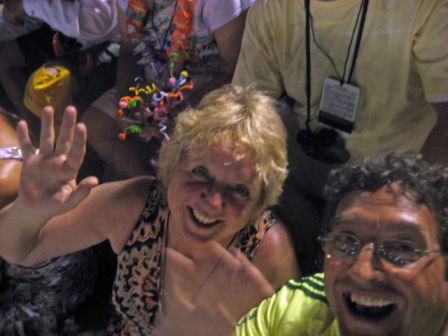Take Off
xxLytham |
iiiRio de Janeiro |
Paris to Santiago.

Although only 45 degrees West of Lytham with a time difference of three hours, the distance to Santiago is one third of the circumference of the globe.
Looks like we have been lucky!
This from the BBC on the night before we travel: Winds of up to 140km/h (87mph) have hit northern and western France, disrupting power supplies and transport routes.
Both main airports serving Paris - Charles de Gaulle and Orly - are closed for the first time in 34 years.
Air France said it had cancelled 210 flights, and has booked more than 2,000 hotel rooms for stranded passengers.
The airports are not due to reopen until 1000 (0900GMT).
Santiago
After 24 hours travelling we arrived at Benetez Airport and quickly passed through customs and found our coach which took us to the Intercontinental Hotel where our rooms were ready. We had a quick look around the area to get water and snacks before meeting up with everyone for a guided city tour. We saw the residential districts of Las Condes and Providencia, famous for their lively streets and beautiful homes and gardens. Then we took a funicular up San Cristobal Hill with a spectacular view of the city. 33 degrees, and sunny
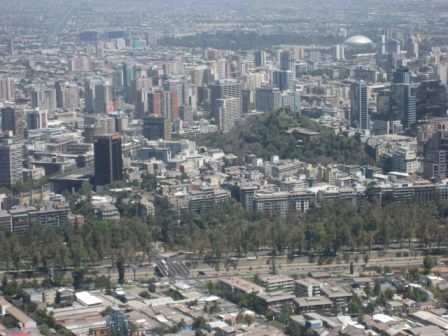
The small green hill in the photograph is the hill where Santiago was founded on the 12th April 1512. Tomorrow will be the 497th anniversary of this event but no one seems to be taking any notice.
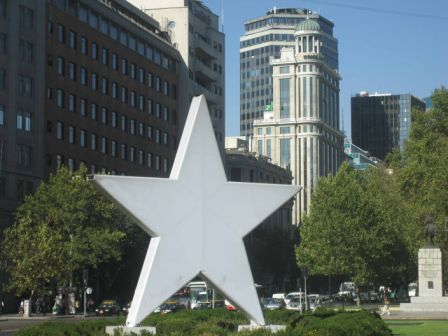
Dinner at a small roadside restaurant was, you guessed it, Fillet Mignon and local beer followed by an early night to set us up for our 6:30 wake up call.
Negra and Pomaire
More sunshine and blue skys.
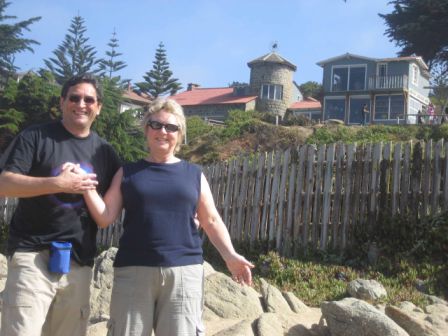
We visited El Quisco and Isla Negra the home of Pablo Neruda the famous Chilean poet, where his collection of shells and nautical objects are kept. The house, which can be seen behind us, was built gradually in a wonderful location looking out over the Pacific . The house is full of subtle designs both humorous and sensitive to nature. The beach is very dangerous with large waves crashing onto sharp rocks.
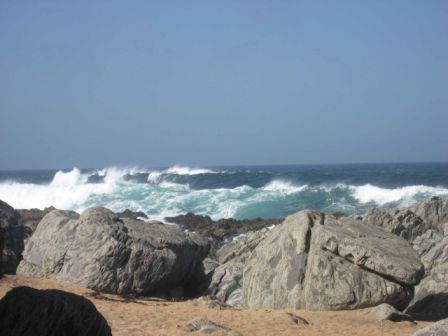
After a visit to a vinyard where we sampled some white wine [which will soon be available in Tesco] we travelled to the village of Pomaire, known for its distinctive form of clay pottery, for a lunch accompanied by a local group of musicians and dancers. With an even earlier start scheduled for tomorrow we ended the day with dinner and an early night. We are sorry to leave Santiago tomorrow, It is a wonderful city full of interest.
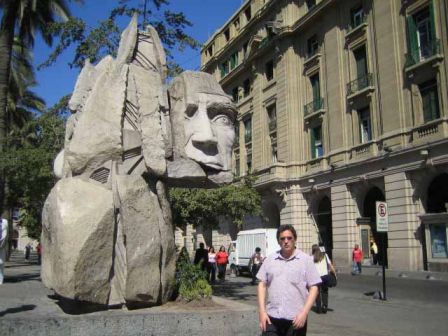
Over the Andes
Morning departure by coach from Santiago for the drive to the border with Argentina. For a short while are road runs parallel to the North American Highway, which runs from here all the way to Alaska. Our journey took us over the Andes with views of Mount Aconcagua which at 23,000ft is the highest peak in the Americas. Even the foothills outreach the peaks of the Canadian Rockies. This spectacular trip fails to be captured by the camera from a coach in the early morning however one or two do it justice.
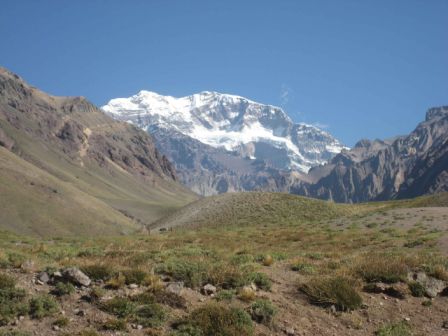
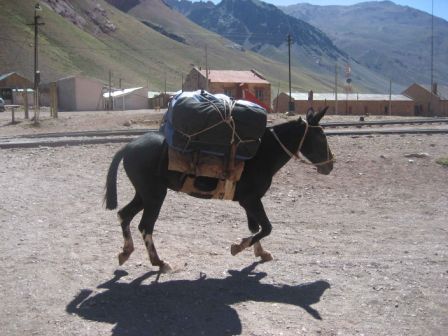
On the way to the border we here stories of how in the past it has been blocked for political reasons or bad weather. Such an event would be we have to turn around and drive all the way back to catch a flight. But we breeze through. After crossing the border into Argentina we continued to Mendoza. This is a small town in the wine producing area of Argentina. The first thing we notice is the Internet is free! The second is the temperature which is 35.
Mendoza
Argentina stretches from tropical jungle in the north to the polar ice of the far south. Mendoza lies at the foot of the Andes and is located in the very heart of the beautiful wine country. This morning we met our local guide for a city tour. We got about two hundred Metres before passing one of the six stadia used for the 1978 Wold Cup (Just to remind you that is the one Argentia won and England failed to qualify for). A further hundred Metres and Maradona's name came up but that was a different year.
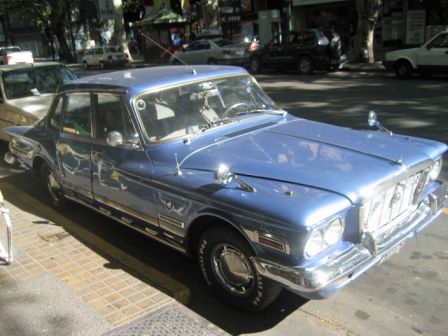
Mendoza is the wine capital of Argentina and produces more than 60% of the country’s wine. This morning we visited a winery. The high quality grapes from this region are used to produce the Chenin Blanc and Sauvignon Blanc white wines and the Cabernet Sauvignon, Merlot and Tempranilla red wines. The country’s most successful wine is the delicious Malbec red wine.
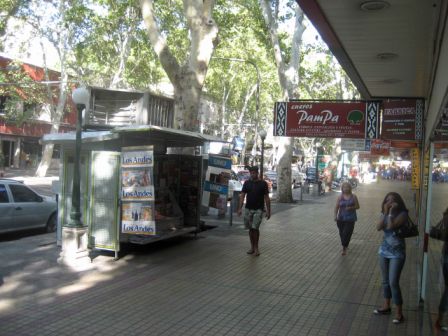
Mendoza is situated in semi-desert and relies on a system of canals to irrigate the city which has over one million trees. The city is set out on a grid system. The water comes from melt water in the Andes which forms the Mendoza river. This has been controlled with a dam and now also provides electricity for the region. But the city suffers many Earthquakes every day. Normally so small they go unnoticed but in 1861 60% of the population of Mendoza was lost in an earthquake that destroyed the city. Now the city does not build skyscrapers and has built into the grid system a series of open squares which function as meeting places in the evening but more importantly as safe areas during Earthquakes.
We stay in the Hotel Aconcagua which looks after us very well.
Buenos Aires
A morning internal flight brought us to Buenos Aires, often referred to as ‘The Paris of the Americas’. Upon arrival we took a tour of the city and saw the Plaza de Mayo where the Casa Rosada (Government House) is situated. Also in the square is the Cathedral of Buenos Aires where the tomb of General San Martin, the hero and liberator of Argentina, is located. Then we went to THE balcony...
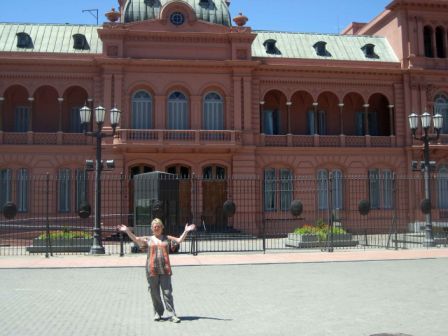
We had a short visit to the Recoleta cemetery, famous for its beautiful family tombs and the burial place of Eva Peron. For lunch we went to the La Boca District renowned for its brightly painted houses. It has now become an artists’ colony. The 'tango' was born here.
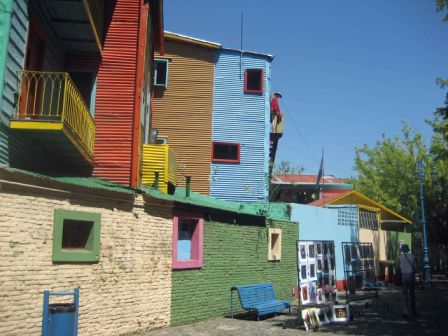
For dinner we walked Florida Street to a typically busy restaurant where we had a leisurely meal and a stroll back in the sweltering heat. This country is pudding heaven. The South Americans appear to have a sweet tooth.
Argentina’s Pampas
A full day into the heart of Argentina’s Pampas to a typical ‘estancia’ for a typical Argentine barbecue lunch. Opportunities to ride some of the beautiful horses or dance with the Gauchos in a wonderful Tango show.
Then the Gauchos play this game of collecting the ring hanging from the arch on their fingers and when they do they trade it for a kiss.
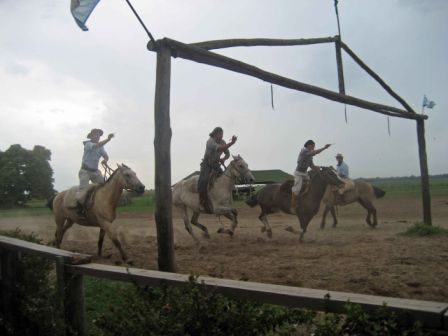
The horses are exceptionally beautiful and in good fettle. They group themselves into families all of the same colouring and marking. Wide awake and alert they appear to love the performance.
Buenos Aires

Today we have a free day until the evening and we first visited the famous Tortoni's restaraunt where we performed a tango for everyone in the theatre. Later we revisited the Bocca taking a white knuckle taxi ride through the Streets and pavements of the city.
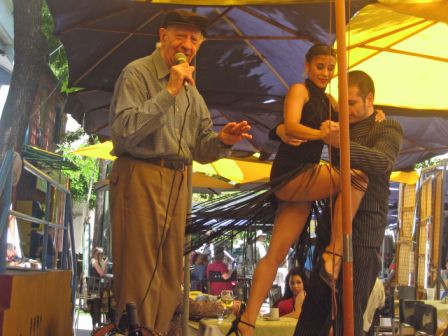
In our leisurely visit we had time to speak to many of the locals. We were surprised when Maradonna introduced himself to Liz.
A taxi back to the main square followed by lunch (Curry & Caesar Salad) and a siesta. There is a flight from here to Sydney which crosses the South Pole!
Iguacu Argentina
We take an internal flight to Iguacu. The temperature goes up a notch, the humidity up three as we land in this semi tropical region in the jungle. Situated at the meeting point of three countries (Brazil, Paraguay and Argentina), the Iguacu Falls are one of the world’s largest natural wonders. They are higher than Niagara, wider than Victoria and consist of 275 separate falls, pouring up to eight million gallons of water every second into the swirling river below. It is a sight of stunning beauty and magnitude. We explore the Argentinean side of the falls. This is a National Park and a series of walk ways takes us through the jungle to various vantage points. The Devils Throat is the deepest...
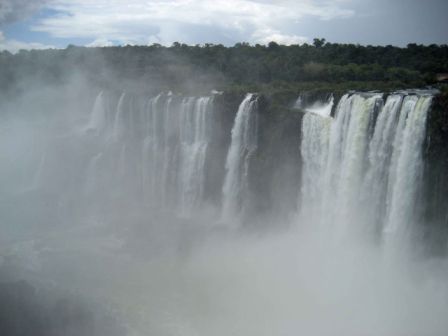
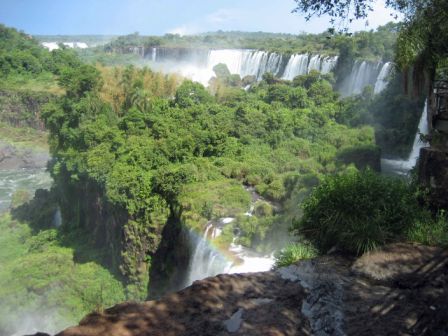
... the Missionary Falls the most beautiful. We will go to the foot of these by boat tomorrow from the Brazilian side. We then crossed the border into Brazil and checked into our hotel where we had a Caipirina and dinner.
Iguacu Brazil
Iguasu is one of over thirty national parks in Brazil. The largest is the size of the UK. The falls are very impressive, but it is the dry season. Twenty Kilometres upstream is a dam which was the biggest in the World until the Yangtze. The dam has produced a lake which contains enough water to give every person on the planet six litres. We choose the boat safari which starts with a walk in the jungle trail drown to the river. Here we learn that most of the plants in the jungle rely on animals and insects to reproduce themselves or protect them in one way or another. The high speed boat is a thrilling ride offering views of the falls.
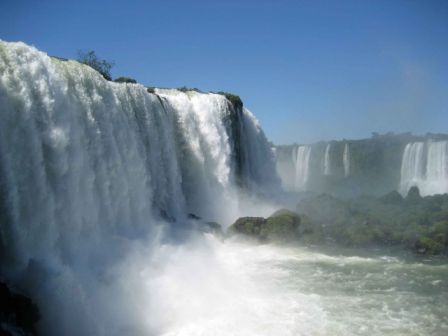
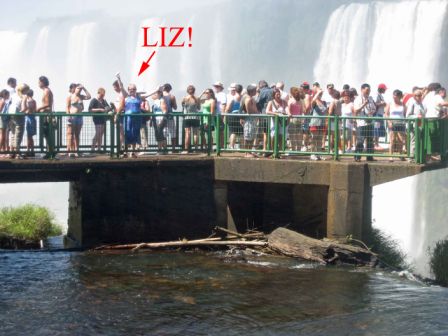
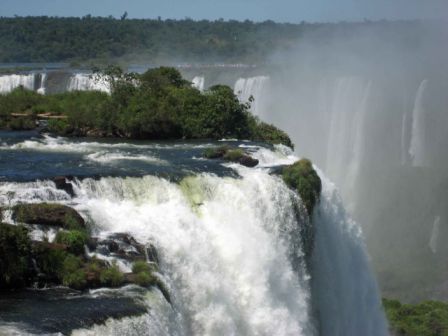
Then we go under one, then another and another until we loose count.
On the way back the captain does some high speed turns and manoeuvres which prevent us drying completely in the hot sun. We did not avail the helicopter but went back to the hotel pool for Caipirina.
Rio de Janeiro
Brazil is the fifth largest country in the world. It is a land of warm sun, bright colours, irresistible rhythms, unsurpassed natural beauty and captivating contrasts. It is a country of carnival, coffee, soccer, sex and samba. Rio de Janeiro is unique simply bursting with energy, excitement and entertainment. It is beautifully situated beneath Sugar Loaf Mountain, and blessed with magnificent beaches such as Copacabana and Ipanema. It is chaos. Here is what you do: 1) load 4 megawoofeertweeter speakers onto your roof rack. 2) Park somewhere central, say a zebra crossing or middle of road. 3) turn music on full blast and wait for band to turn up. 4) mobile food shops move in. 5) mobile iced beer sellers move in. 6) When band turn up, if they are good then lorry of iced beer moves in.
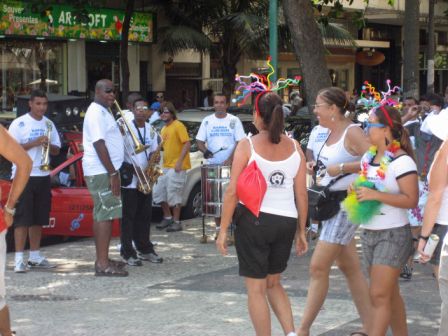
Turn the temperature up a notch more and the humidity another three notches. The Atlantic is cold and the land hot. A gentle mist comes in from the sea over the many beaches creating the steam room effect.
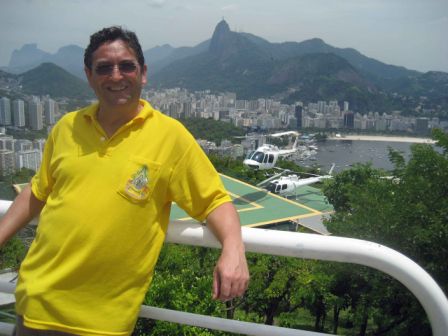
A helicopter ride over the city must be very spectacular. They circle Corcovada on the trip.
Corcovado
Most of the locals with cars have now left Rio to the avalance of visitors. Cruise ships are hours away from arriving but we head off to see Corcovada and Sugar Loaf in one trip. To reach the Corcovado statue it is necessary to ascend in a small cog railway which winds up the mountain.
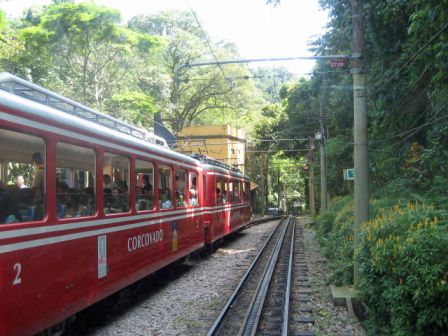
Our local guide tells us how lucky we are with the weather and visibility. Seldom is it ever this good.
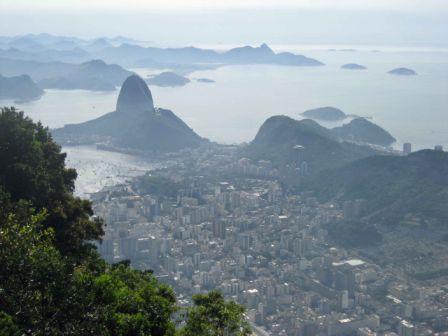
To go to the top of sugar Loaf takes two cable cars. The views offered show a different perspective of the city with more detail.
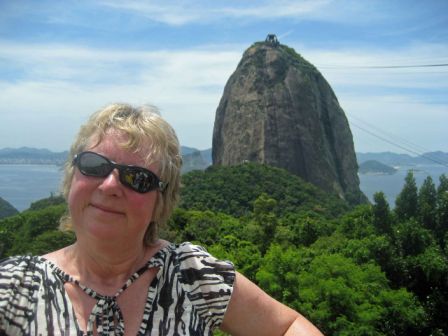
The carnival atmosphere is building. More and more music is being played on street corners.
Sambadrome Stadium
The greatest party on Earth is actually a competition. There are twelve schools in the first division which perform on Sunday and Monday. There are ten groups of five Judges each responsible for a different element of the parade. The top and bottom mark are disregarded so it is marked out of 300. Typically the winner will score 297. One school will be relagated and be replaced by the winner of the second division. Results will be published on Thursday on the official website. No words can describe being at the event and selecting a couple of pictures from the 450 taken is difficult, but here goes:
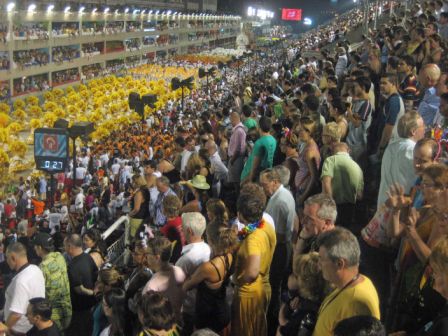


Each Samba School has to create a song for the parade. Here are the songs for 2009
Rio Carnival 2009 starts on Friday, February 20th and ends on Fat Tuesday, February 24th.
Although Carnival is celebrated in towns and villages throughout Brazil and other Catholic countries, Rio de Janeiro has long been regarded as the Carnival Capital of the World. The Rio carnival is not only the biggest Carnival, benchmark against which every other carnival is compared but also one of the most interesting artistic events on the Globe. Foreign visitors to it alone number around 500,000 every year.
Rio Carnival is a wild 4 day celebration, 40 days before Easter. It officially starts on Saturday and finishes on Fat Tuesday with the beginning of Lent on Ash Wednesday after which one is supposed to abstain from all bodily pleasures. Carnival with all its excesses, celebrated as a profane event, can thus be considered an act of farewell to the pleasures of the flesh. It usually happens in February, the hottest month in the Southern Hemisphere, when the Rio summer is at its peak.
There are carnival celebrations in virtually every corner of Brazil, the best-known ones taking place in Recife together with the neighboring Olinda (in the Northeast of Brazil) and Salvador. But the biggest and most famous carnival is undoubtedly the Carnival in Rio de Janeiro.
One of the greatest elements of the Rio carnival is that it not only provides entertainment for many people around the world but at the same time it gives also a chance to learn about the true culture of Brazil. Carnival is very important to the Brazilians being their very rich cultural manifestation. It is a euphoric event where people dance, sing, party and have tons of fun. There are many parties that take place before, during and after Carnival all night and all day. It allows someone's true heart to come out and have as much fun as possible.
Rio Carnival is the result of months of preparation. People eagerly anticipate the start of each year's Rio Carnival. It begins with the crowning of the Fat King (King Momo), who is presented with a giant silver and gold key by the city's mayor. Almost all of the music played during Rio Carnival is samba. It is a uniquely Brazilian music originating from Rio and a dance form that was invented by the poor Afro-Brazilians.
The samba schools are vital elements of Rio Carnival. They are social clubs representing a particular neighborhood, usually a working class community of the favelas. They have a samba hall to entertain and practice their samba and a separate production unit to make their costumes and floats for their Rio Carnival Parade. The samba schools entertain the community through samba nights and create a pageant for the Samba Parade. They have to pick themes, write music and lyrics, make costumes and floats and practice all year around to succeed in the Parade.
Rio Beaches
We left the Sambadrome at dawn and arrived back at the hotel about 7am and managed to catch up on sleep. Here are some photos we took of the beaches earlier.
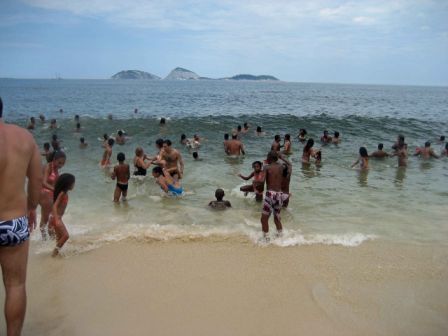
Iponima - A big wave coming in. Carnival is when the locals take over!
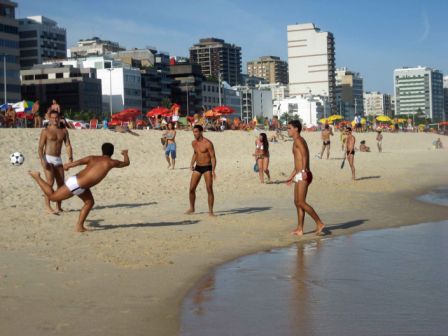
Leblon - the select end of Rio.
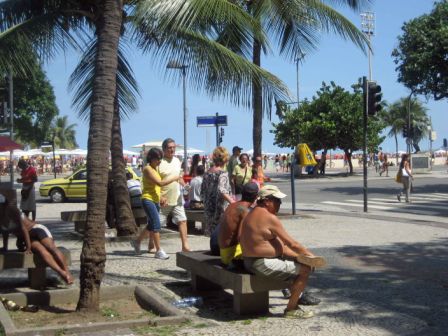
Copacobana - where we are staying.
As we finished dinner, the first Samba School from this evenings parade was just starting on TV. As we got back to our room it was just finishing. We watched the next one right the way through then got some more sleep.
Free in Rio
We are free in Rio until departure to the airport for return flight to the UK at lunchtime. we are very sorry to be leaving the tour. Nevertheless we are not built for this relentless humidity and temperature and so we must accept, while enjoying the better weather while snow and rain fall in the UK, we belong in temperate climates. In Rio at carnival there is a huge clean up operation going on all the time. The endless demand for bottled water means that mountains of empty bottles are produced each hour. Cans are collected and recycled at an equally fast rate. Despite this, nothing ever runs out. So we escape to the hotel room for a cool shower while others are not so lucky, however they are perhaps more used to the climate than us.
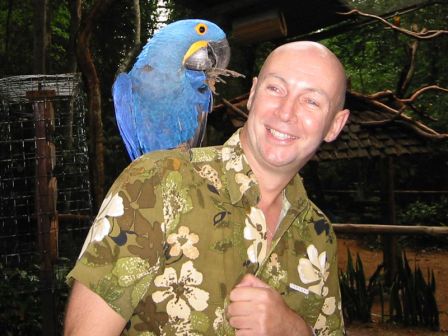
Our trip went like clockwork thanks to Brian Croft - Tour Manager extrordinere. Google him!
Home
Rio to Paris and Manchester
Three hours less than the outward flight.

To sum things up seems impossible. Just look at what we have done and where we have been. Everything has gone our way. We are the 'lucky tour'.
